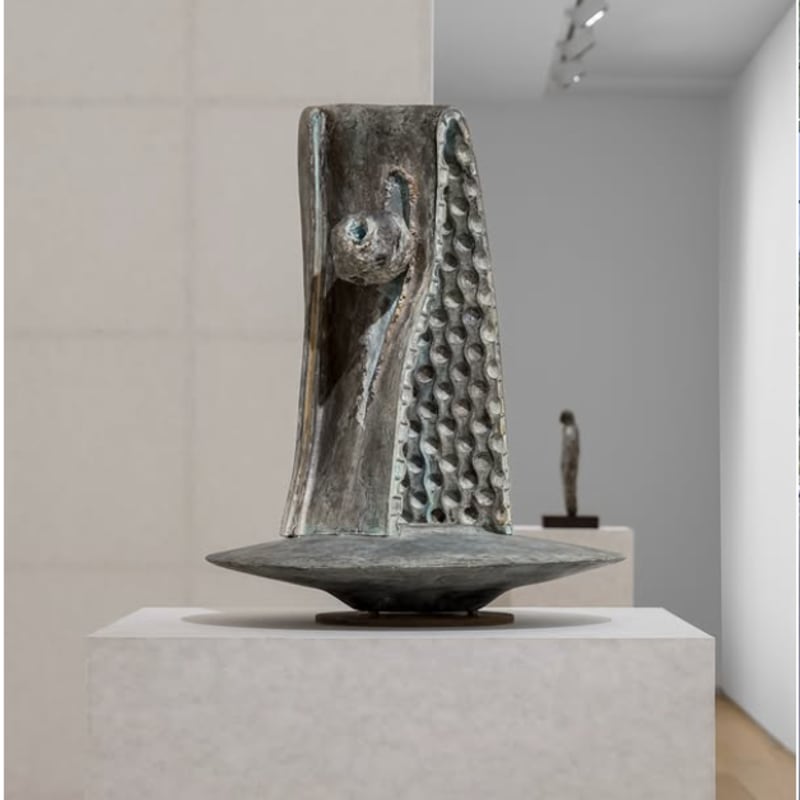Revisiting the earliest meetings of Andy Warhol and Joseph Beuys in 1979, this exhibition brings together a group of Warhol’s celebrated portraits of Beuys. While the Beuys portraits are held in the collections of major institutions internationally – including The Museum of Modern Art, New York, Philadelphia Museum of Art, and Tate, London – this is the first time the works have been presented with a solo focus since they were exhibited in the 1980s.
The Beuys portraits demonstrate Warhol’s characteristically experimental approach to materials and technique, which position him as one of the foremost portraitists of the 20th century. He pursued variation in his approach to colour, composition and medium, rather than with the image itself, resulting in great diversity within the body of work, including some of the artist’s earliest uses of diamond dust in portraits.
For those who witnessed them approaching each other across the polished granite floor, the moment had all the ceremonial aura of two rival popes meeting in Avignon.
— David Galloway, 1988

Warhol and Beuys first met each other in person at an exhibition opening in Düsseldorf, Germany, marking a key point of contact between the leading representatives of American and European art.
The two giants of art history met on several further occasions that year, including on 30 October 1979 during the installation of Beuys’s landmark retrospective at the Solomon R. Guggenheim Museum in New York. The German artist visited Warhol’s studio to have his portrait taken, arriving at the same time that Georgia O’Keeffe was being photographed.
Image: Mimmo Jodice’s photo of Warhol and Beuys, 1980. Photograph: Antonia Reeve/Joesph Beuys/National Galleries of Scotland/Tate

Joseph Beuys (Reversal), 1983
Acrylic, silkscreen ink and diamond dust on canvas
213.4 x 177.8 cm (84 x 70 in)

Synthetic polymer paint, diamond dust and silkscreen ink on linen
30.5 x 85.4 cm (12 x 33.62 in)

Silkscreen ink and diamond dust on canvas
101.6 x 101.6 cm (40 x 40 in)

Joseph Beuys, 1980
Acrylic and silkscreen on canvas
102 x 102 cm (40.16 x 40.16 in)

Despite fundamental differences in their philosophical approaches to artmaking, Warhol and Beuys shared an alchemical ability to render everyday objects and images unfamiliar through their practices, as well as a compulsion towards self-stylisation as they carefully cultivated their respective public images: Beuys was the shamanic artist whose mythical origins lay in his rescue from a plane crash by nomadic Tatars, while Warhol cultivated his public image as the ‘Pope of Pop’, instantly recognisable in his silver-blonde wig.

Acrylic and silkscreen on canvas
50.8 x 40.6 cm (20 x 16 in)
![[The portraits] are a rich record, an amazing parade of faces, an insight for future generations into the European and...](https://artlogic-res.cloudinary.com/w_1400,h_1400,c_limit,f_auto,fl_lossy,q_auto:good/ws-ropac/usr/images/feature_panels/image/5252/aw_1279_300dpi_1.jpg)
[The portraits] are a rich record, an amazing parade of faces, an insight for future generations into the European and American culture of [Warhol’s] time. — Vincent Fremont, Executive Studio Manager & A Founding Director of the Warhol Foundation
Joseph Beuys, 1980
Silkscreen with diamond dust on brown paper; framed under glass
121.9 x 91.4 cm (48 x 36 in)

While in the 1960s Warhol’s first significant group of portraits critiqued the commodification of celebrity images as he created glamorous renditions of Marilyn Monroe, Jackie Kennedy and Elizabeth Taylor, in the 1970s and 1980s, his scope expanded through his commissioned portraits to reflect his fascination with the cultural and political icons of the 20th century. This resulted in a number of artist portraits, including those of Jean-Michel Basquiat, Man Ray, Robert Mapplethorpe and, of course, Joseph Beuys.
Joseph Beuys, 1980
Silkscreen ink on paper
100 x 79 cm (39.37 x 31.1 in)

Joseph Beuys, 1980–3
Unique Trial Proof screenprint with rayon flock on Lenox Museum Board
101.6 x 81.3 cm (40 x 32 in)

Warhol transformed his photographic source material through a process of simplification. He removed extraneous details to produce emblematic, icon-like representations of his sitters, which were then screenprinted onto different supports. ‘With silkscreening,’ he explained, ‘you pick a photograph, blow it up, transfer it in glue on silk, and then roll ink across it so the ink goes through the silk but not the glue. That way you get the same image, slightly different each time.’
Joseph Beuys, 1980–3
Unique Trial Proof screenprint on Lenox Museum Board
50.8 x 81.3 cm (20 x 32 in)

Created at the same time as the screenprinted portraits of Beuys, this drawing demonstrates Warhol’s ability to deftly translate images across mediums. Drawing was a sustaining activity for the artist across the four decades of his intensely productive career: from his early work as a commercial illustrator and the erotic drawings of the 1950s to his late, hand-drawn portraits. With its confident, graphic simplicity, this graphite depiction of Beuys demonstrates the skilled draughtsmanship that underpinned Warhol’s use of printing technologies, offering a unique insight into the range of his mark-making when working with an image.
Joseph Beuys, c.1980
Graphite on paper
80 x 58.4 cm (31.5 x 23 in)






























































































































































































